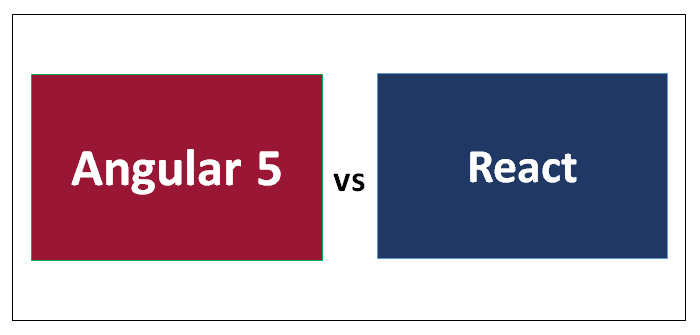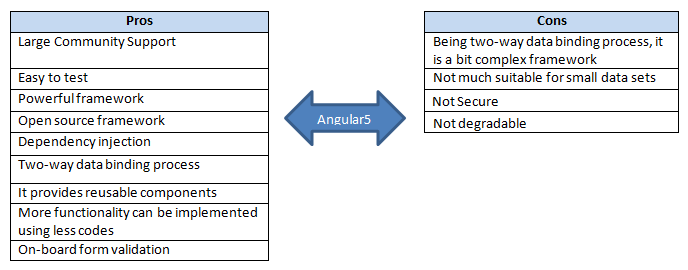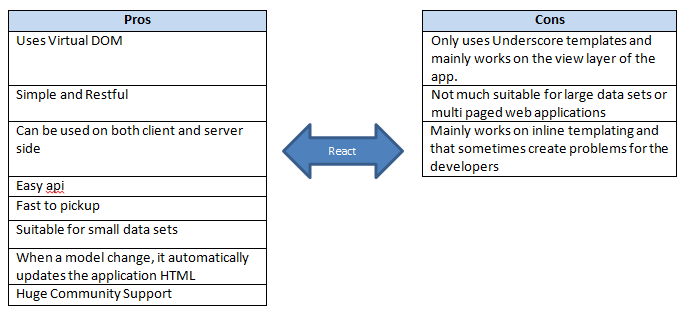Updated April 17, 2023
Difference Between Angular 5 vs React
Angular is basically a TypeScript-based open-source front-end web application platform led by the Angular Team at Google. Angular5 vs React is a Javascript-based open-source standalone framework designed to support the development of data-intensive web applications and test-driven development. It was born in 2009 as a part of a large commercial product.
Important Features
Following are some important features of Angular5 and React:
Features of Angular 5
Some of the important features of Angular 5 are mentioned below:
- Two-way data binding process
- Dependency injection
- Easy to test code
- Deep Linking
- Routing
- Controller
- Extending the functionality of HTML attributes with Directives.
On the other hand, React is basically a javascript library that is mainly used to build and implement the user interphase. React was initially created by Jordon Walke, employed at Facebook. It is now one of the most popular javascript libraries used in the current software industries.
Features of React
Find below few important features of React.
- JSX – It is mainly an extension and is often recommended and used as a part of React JS libraries.
- One-Directional flow – React is mainly implemented in a single way data flow, making it easier for the app to be built and interphase upgradation.
- Structure and Components – It comprises different components and can enhance and utilise the apps for small to large scale projects.
- License – React is licensed under Facebook and has huge community support for the same.
Pros and Cons of Angular5
Find below a few pros and cons of Angular 5:
Pros and Cons of React
Find below a few pros and cons of React:
Head to Head Comparisons Between Angular 5 and React (Infographics)
Below is the top 7 difference between Angular 5 and React:
Key Differences between Angular 5 and React
Both Angular 5 vs React are popular choices in the market; let us discuss some of the major difference between Angular 5 and React :
- Angular 5 is a powerful Javascript based standalone framework, whereas React.js is a lightweight javascript framework.
- Angular 5 uses a two-way data binding process, whereas React.js doesn’t provide any data binding process and so it is not suitable for large web page development. React is mainly used in the case of a small web page or small data sets in the development process.
- React has its license under Facebook and thus has one of the bigger community support than its competitors. On the other hand, Angular is backed by Google; it also has huge community support.
- In the case of the performance aspect, React.js is faster than Angular 5 for small data sets.
- Angular 5 is very much easy to test. Also, from the development perspective, unit testing is smoother in Angular 5 than in React.js.
- js can provide greater flexibility according to the different features that need to be incorporated within the app.
- Angular uses MVC, whereas React uses MVP architectures.
- Angular 5 mainly focuses on valid HTML dynamic elements, whereas React.js relies upon direct DOM manipulation to represent data changes.
- In the case of Angular 5, it has a lesser code implementation approach, and thus multilinear codes can be more easily implemented than its competitors.
Angular 5 and React Comparison Table
Here are some of the comparison between Angular 5 and React.
| The basis of comparison Between Angular 5 vs React Performance |
Angular 5 |
React |
| Basic Performance | Angular 5 is one of the known open source frameworks and provides impactful performance for larger pages as it offers a two-way data binding process. | React.js provides much faster performance than Angular 5 in the case of small data sets or small pages. But for larger pages, it is not that much preferred as it doesn’t do any data binding process. |
| Architectural Performance | Angular 5 works on MVC architecture, and it uses two-way data binding to drive application activity. | React.js uses MVP architecture, and it doesn’t provide any data binding process. |
| Performance-based on Templating | Angular 5 offers to the template through dynamic HTML attributes, which are added to the document to make an easy to understand application at a functional level. | React.js uses Underscore templates. These templates are not as fully-featured as those offered by Angular. |
| Performance Testing | Performance testing is more preferred in Angular than React. Mainly in the case of a large application, testing is smoother through this framework. | React.js doesn’t provide any data binding process, and thus it mainly provides a swift testing experience for a single page or smaller applications. For big or multi-paged applications, it is less preferred than Angular5. |
| Support and Performance Upgradation | Angular 5 has large community support and extensive documentation libraries. It is also backed by Google. | React.js is under Facebook license and thus has one of the largest community supports. |
| Data binding Performance | Angular 5 implements a two-way binding process, and thus it is a bit complex than React.js. | React doesn’t provide any data binding and has a simple and easy API than Angular 5. |
| Performance-based on advanced Features | Angular 5 mainly focuses on valid HTML and dynamic elements that mirror the underlying data to rebuild the DOM as per the specified rules. It then works on the updated data records. | React.js works on a direct DOM manipulation approach to represent changes in data and application architecture. |
Conclusion
After comparing Angular 5 vs React over a range of factors, it can be concluded that each one has its own pros and cons. So, before choosing any one of them, developers should learn and analyze different aspects of both React vs Angular 5. Thus, based on the type of project need, time of work and all other different discussed aspects, any of these two should be selected to reach the desired goal.
Recommended Articles
This has been a guide to the top difference between Angular 5 vs React. Here we have discussed Angular 5 vs React Performance head to head comparison, key difference, and infographics and comparison table. You may also have a look at the following articles to learn more –




